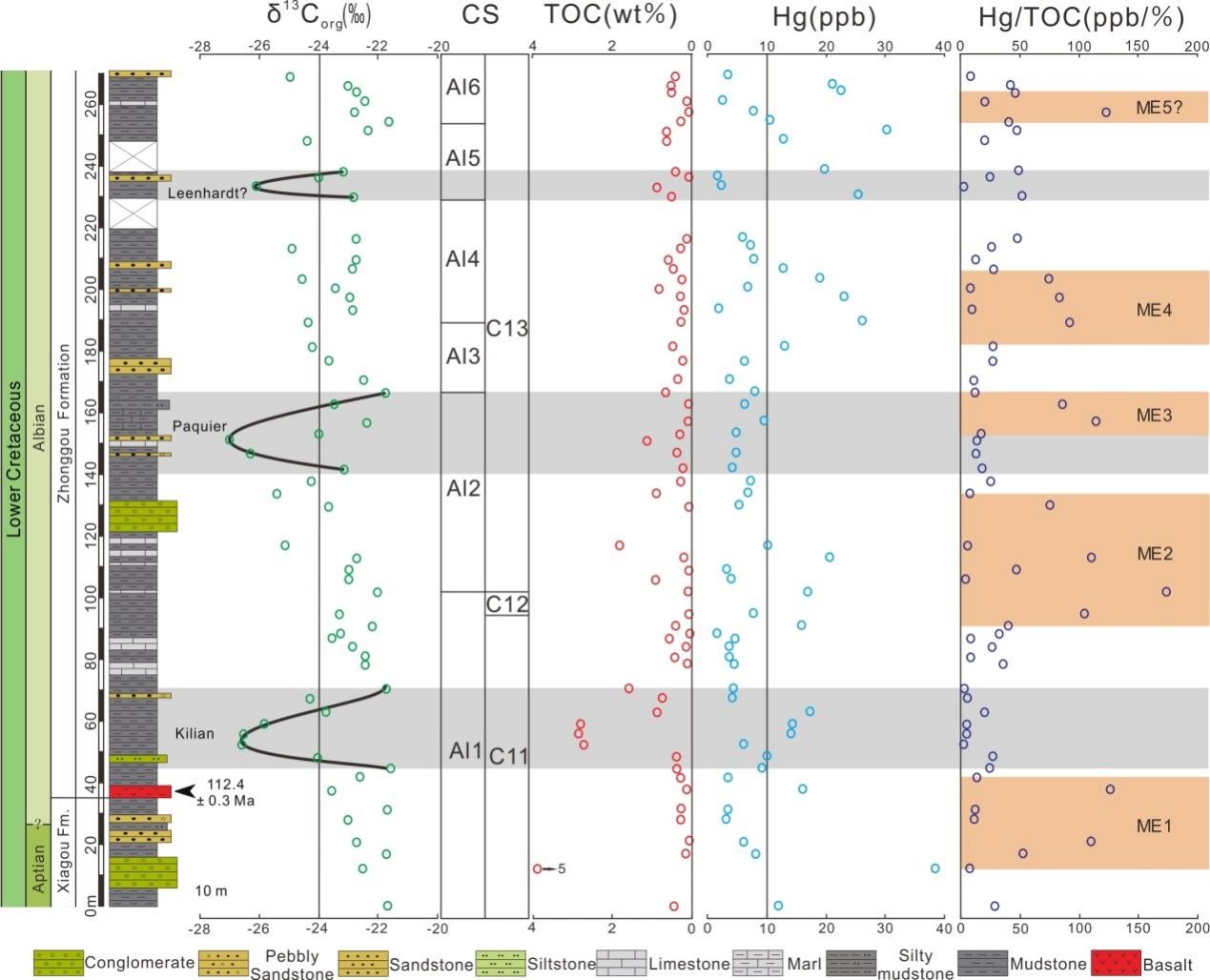The Cretaceous paleo-ocean has experienced multiple phases of Oceanic Anoxic Events (OAEs), which characterized by organic carbon enrichment, geochemical indicator anomalies and fossil assemblage changes. It includes three events, namely OAE 1, OAE 2 and OAE 3.
Previous studies of OAE 1b events have been mainly based on marine sediments in western Tethys, and very little research has been conducted on Eurasia, which limits our insight into the response of terrestrial ecosystems to OAE 1b.
Recently, ZHAO Xiangdong, a graduate student supervised by Prof. ZHENG Dajin and ZHANG Haichun, from the Nanjing Institute of Geology and Palaeontology, Chinese Academy of Sciences (NIGPAS), has found the first record of OAE 1b events in the Xiagou Formation and Zhonggou Formation of the Hanxiagou Section in Jiuquan Basin, northwestern China. The results provide direct evidence to link the OAE 1b and terrestrial ecosystem in the Eurasia. The research results have been published in GSL Special Publications, an international geological journal.
"In this work, we present organic carbon isotope and total organic carbon (TOC) content data analyzed from a terrestrial succession in the Xiagou and Zhonggou Formations (upper Aptian-lower Albian), in order to characterize the OAE1b in the Eurasia continental sediments," ZHAO says, "specifically, we also analyze Hg concentrations to investigate changes in the flux of volcanic materials to terrestrial environments during the OAE 1b."
On the basis of zircon U-Pb age of 112.4 ± 0.3 Ma for a basalt layer from the lowermost Zhonggou Formation, the three negative δ13Corg excursions, well corresponded with the three subevents (Kilian, Paquier, and Leenhardt) of the OAE1b in the Poggio le Guaine (central Italy), Vocontian Basin (SE France) and Santa Rosa Canyon (NE Mexico) Sections, supporting the record of the terrestrial OAE 1b in the Jiuquan Basin.
Five mercury enrichment intervals in Hg/TOC ratios were recognized in the Hanxiagou Section, showing a high agreement with the previous study in the Poggio le Guaine section. This consistency indicates that mercury in both sections were probably from the same source. The volcanic eruptions of the Southern Kerguelen Plateau (119.0 –109.2 Ma) provided the Hg source and probably triggered the OAE1b (~114.5–110.5 Ma). The multiple long-term spikes observed in the Hg/TOC profile could further reflect a multiple phase emplacement of the volcanism.
The Hg/TOC spikes and Carbon Isotope Excursions are not strictly at the same positions in both sections, which means a potential decoupling relationship between the global shifts in δ13C and the volcanic activity (suggested by Hg/TOC). This decoupling relationship may be resulted from another unstable and unknown carbon reservoir (not directly linked to Hg emissions) activated after the volcanism.
This work was supported by the Strategic Priority Research Program of the Chinese Academy of Sciences, the Second Tibetan Plateau Scientific Expedition and Research, and the National Natural Science Foundation of China.
Reference: Zhao, X.D., Zheng, D.R., Wang, H., Fang, Y.N., Xue, N.H. & Zhang, H.C. (2021). Carbon cycle perturbation and mercury anomalies in terrestrial Oceanic Anoxic Event 1b from Jiuquan Basin, NW China. GSL Special Publications. http://dx.doi.org/10.1144/SP521-2021-149.

Fig. 1 Section photograph showing boundary (red line) of Xiagou and Zhonggou formations in Hanxiagou section

Fig. 2. Geochemical profiles at Hanxiagou section

Fig. 3. Correlation of carbon isotopic records in Hanxiagou section (Jiuquan Basin, NW China), Poggio Ie Guaine section (Umbria–Marche Basin, Italy), a composite section (Vocontian Basin, France) and the Santa Rosa Canyon section (Mexico)
Contact:
LIU Yun, Propagandist
Email: yunliu@nigpas.ac.cn
Nanjing Institute of Geology and Palaeontology, Chinese Academy of Sciences
Nanjing, Jiangsu 210008, China
Download:
